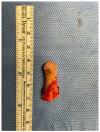Jacob's Disease: Case Series, Extensive Literature Review and Classification Proposal
- PMID: 36769586
- PMCID: PMC9917974
- DOI: 10.3390/jcm12030938
Jacob's Disease: Case Series, Extensive Literature Review and Classification Proposal
Abstract
Jacob's disease is a rare entity consisting of the formation of a pseudojoint between an abnormal coronoid process of the mandible and the inner surface of the zygomatic bone. First described by Jacob in 1899, its diagnosis and definition have never been entirely univocal. In this paper, we present three emblematic cases and an extensive review of the literature on Jacob's disease. Given the variability observed in the presentation of the disease, we have developed a proposal for the classification, here reported.
Keywords: Jacob’s disease; coronoid hyperplasia; osteochondroma; temporomandibular surgery.
Conflict of interest statement
The authors declare no conflict of interest.
Figures












References
-
- Jacob O. Une cause rare de constriction permanente des machoires. Bull. Mem. Soc. Anat. Paris. 1899;1:917.
-
- Langenbeck B. Angeborene Kleinert der Unterkiefer. Langenbecks Arch. 1861;1:451.
Publication types
LinkOut - more resources
Full Text Sources

